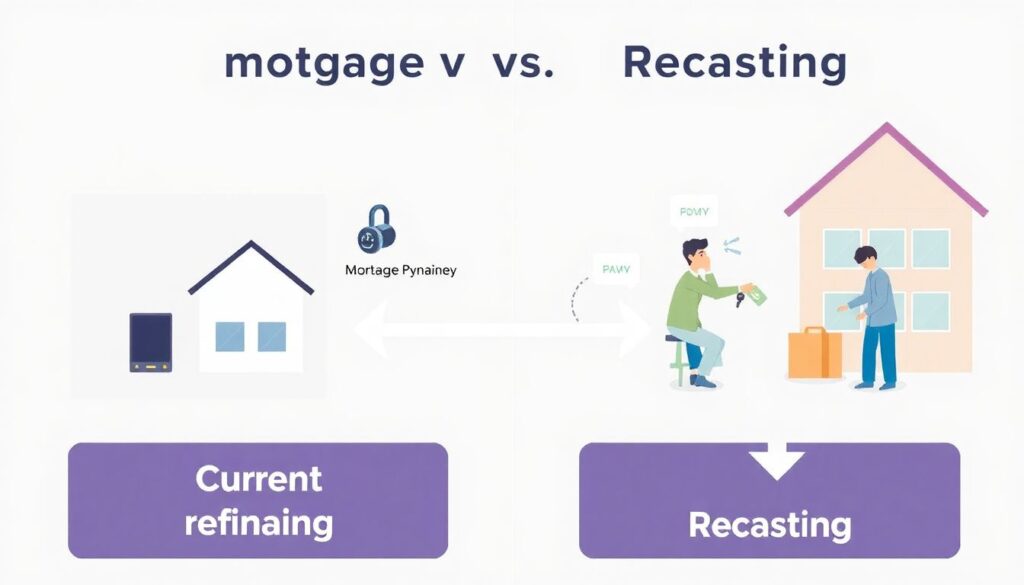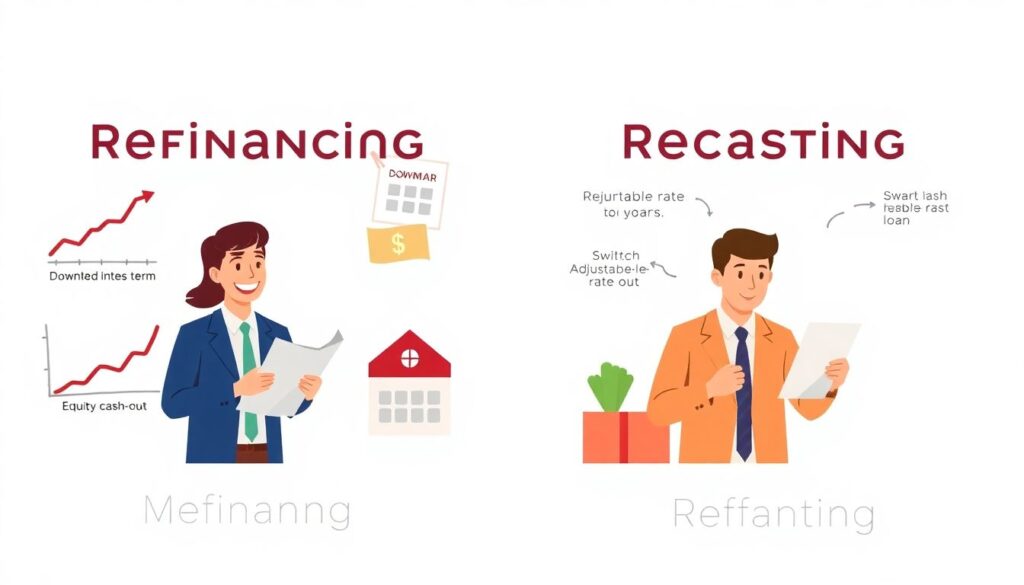Understanding the Basics: What Is Refinancing?
Refinancing a mortgage refers to the process of replacing an existing home loan with a new one, typically with different terms such as a lower interest rate, different loan duration, or a switch between fixed and adjustable rates. Homeowners often refinance to reduce their monthly payment, shorten the loan term, or tap into home equity for cash-out purposes. This procedure involves applying for a new loan, undergoing credit checks, home appraisal, and paying closing costs—often ranging from 2% to 5% of the loan amount. For example, refinancing a $250,000 mortgage might cost between $5,000 and $12,500 in fees, but could result in long-term savings if market rates are favorable.
Recasting Explained: A Streamlined Adjustment
Mortgage recasting, unlike refinancing, keeps the original loan structure intact but reduces the monthly payments by making a significant lump-sum payment toward the principal. The lender then recalculates the amortization schedule based on the reduced balance, which lowers the monthly obligation but does not change your interest rate or loan term. Recasting typically requires a minimum contribution—usually around $5,000—and a small processing fee (often under $500). For instance, if you pay $50,000 toward your principal, your payment drops accordingly, but your interest rate remains the same. Not all loans are eligible—FHA, VA, and USDA loans often do not allow recasting.
Key Differences Illustrated

Visualize refinancing as replacing your current mortgage altogether—it’s like trading in your car for a new one. Recasting, on the other hand, is more like paying off part of your car loan and renegotiating the monthly payment. Imagine a diagram: Two arrows start from a box labeled “Current Mortgage.” One arrow leads to a completely new box labeled “New Loan Terms” (refinancing), while the other arrow loops back into the same box labeled “Reduced Balance” (recasting), showing that the original loan remains intact.
Comparing Use Cases: Refinance vs. Recast

Refinancing is ideal when:
1. Interest rates have significantly dropped.
2. You want to change your loan term (e.g., from 30 years to 15).
3. You need cash from your home equity.
4. You’re aiming to switch loan types, such as from adjustable-rate to fixed-rate.
Recasting works best when:
1. You’ve come into a windfall (bonus, inheritance) and want smaller payments.
2. You’re satisfied with your interest rate and loan terms.
3. You want to avoid closing costs and lengthy paperwork.
4. Your lender permits recasting on your loan type.
Each strategy provides different benefits depending on your financial goals.
Financial Impact: Cost vs. Benefit Analysis
From a technical perspective, refinancing can offer substantial interest savings over time but comes with upfront costs. For example, reducing your interest rate from 6% to 4% on a $300,000 loan could save tens of thousands in interest. However, if closing costs are high and you plan to sell soon, your breakeven period may be too long to justify the move. Recasting, with its minimal fees, can be a low-cost way to lower monthly payments, but offers limited impact on long-term interest unless done early in the amortization schedule. Financial modeling tools or spreadsheets can help compare total interest paid under each scenario for precise planning.
Considerations Before Deciding
Before choosing between refinancing and recasting, assess the following:
1. Loan Type and Lender Flexibility – Not all lenders offer recasting, and government-backed loans usually aren’t eligible.
2. Time Horizon – If you’re moving in a few years, recasting may be more cost-effective.
3. Cash Availability – Recasting requires a large upfront payment; refinancing may free up cash via equity.
4. Credit Profile – Refinancing involves a credit check and may be difficult with poor credit or income changes.
5. Market Conditions – Favorable interest rates often justify refinancing; stable or rising rates may favor recasting.
Choosing the right approach hinges on a clear understanding of your financial objectives and constraints.
Practical Scenarios: Which Strategy Fits Best?

Suppose a homeowner with a $400,000 mortgage at 5.5% interest suddenly receives a $100,000 inheritance. If their current rate is still competitive and they prefer lower payments without changing loan terms, recasting may be the optimal route. Conversely, another borrower with the same mortgage could benefit from refinancing to 3.75%, despite the upfront cost, especially if they plan to stay in the home for over 10 years. These examples underscore how personal context and market timing influence the strategy.
Conclusion: Aligning with Your Financial Strategy
Ultimately, deciding between refinancing and recasting depends on your long-term goals, current financial health, and market environment. Recasting is a cost-efficient, low-friction option for reducing monthly payments without altering your loan structure, while refinancing can significantly reshape your financial outlook if timed strategically. Evaluate both options carefully, perhaps with the guidance of a financial advisor or mortgage specialist, to ensure your mortgage strategy aligns with your broader economic plans.

